Tag Archive: Language facilitation strategies
October 21, 2020
by Carole Zangari -

Descriptive teaching is a strategy that is widely recommended to support AAC learners. In today’s featured video, we highlight a quick explainer video that captures the essence of this important strategy. Many thanks to Becca Eisenberg, of Language During Mealtime, for this fun video. Direct Link to Video – https://www.youtube.com/watch?v=SUKE2i_VnYY&ab_channel=LanguageDuringMealtime
Filed under: Video of the Week
Tagged With: descriptive teaching, Language facilitation strategies
July 6, 2020
by Carole Zangari -
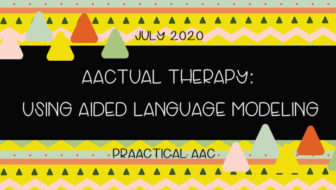
Although we’ve written extensively on the role of modeling in AAC, there are always new perspectives to consider regarding this evidence-based and widely-used strategy. Today, we feature SLPs Kate Grandbois and Amy Wonkka who share their approach to aided language modeling. :::::::::::::::::::::::::::::::::::::::::::::::::::::::::::::::::::::::: Bringing it all Together: Aided Language Modeling Most SLPs working in AAC have come across a variety of different interventions in their practice. Some, like aided language modeling, are popular and commonly seen at conferences. They are the most popular option on the intervention buffet. Others, like discrete trial training, are like the mystery meat – you think you know what it is, you don’t think you’re going to like it, and you’re going to watch while someone else tries it first. Sometimes these teaching procedures are straightforward, and sometimes they are confusing, intimidating, or complicated. You may find that choosing which intervention to use is influenced by... [Read More...]
Filed under: Featured Posts, PrAACtical Thinking
Tagged With: aided communication, Aided Language Input/Stimulation, Language facilitation strategies
July 2, 2020
by Carole Zangari -
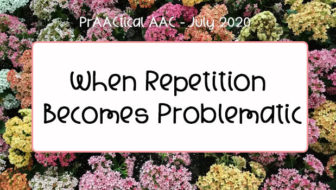
Have you worked with learners like these? Shameka wore a favorite t-shirt, featuring her beloved Moana, to her teletherapy session. She pointed to it to show her therapist and used her AAC device to say “Moana.” After acknowledging her Moana shirt and having a brief conversation about it, the therapist was ready to move on to the activities planned for that session. Shameka continued to bring up Moana many times throughout the session. Bryce’s love of pizza is no secret. It’s so important to him that Bryce can say ‘pizza’ with a word approximation, sign it with his unique version of the manual sign, or use a manual communication board or SGD to say the word. Most days, that’s a very good thing. But sometimes, Bryce starts mentioning pizza early in the morning and brings it up a few times an hour for the rest of the day. Many of... [Read More...]
Filed under: Featured Posts, PrAACtical Thinking
Tagged With: Language facilitation strategies, partner skills & training, visual supports
June 22, 2020
by Carole Zangari -
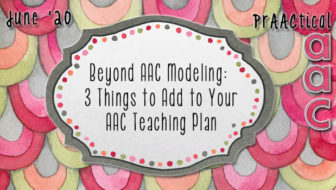
It is hard to overstate the role of aided language input and other forms of AAC modeling when interacting with those who are still developing their language and communication skills. Seeing and hearing others use AAC is important for many reasons. Some AAC users pick up language and AAC skills just through that kind of exposure. Most, however, benefit from explicit instruction on specific skills, such as creating longer and more complex sentences, using morphological endings to change the form of the word, or expanding the range of words they use. They also need support to move from using these skills only during therapy/instruction to using them in a range of functional contexts. Here are some things to add to our intervention to strengthen their AAC learning. Think Aloud Strategy: Narrate the steps of finding what you want to say in their AAC system as you create your message (e..g.,... [Read More...]
Filed under: Featured Posts, PrAACtical Thinking
Tagged With: carryover, generalization, Language Experiences & Activities, Language facilitation strategies, loose training
July 12, 2017
by Carole Zangari -
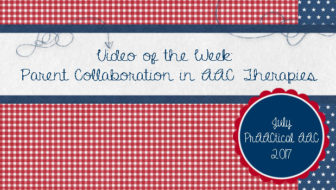
Parents and professionals have so much to teach each other. In this video, we get to peek into a session where collaboration and sharing work to the benefit of the AAC learner. It takes time for skill-building and becoming consistent at using supportive strategies, like aided language input, expansions, and graduated prompting. Whether we are parents or professionals, the learning process takes time. We have to give ourselves permission to move from knowing about AAC facilitation strategies, through using them periodically, to using them consistently. It takes time and lots of practice. Clips from this session remind us that we don’t have to be perfect. We just have to be open to change, willing to try new ways of interacting, and ready to commit to growing our AAC support skills over time. When we do that, kids are the real winners. Thanks to the Louisiana AT Initiative for making this... [Read More...]
Filed under: Video of the Week
Tagged With: collaboration, Language facilitation strategies, parent
June 10, 2015
by Carole Zangari -
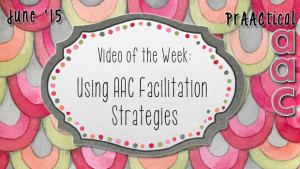
How can adults and peers who serve as communication partners support AAC learners in their interactions? Dr. Rae Sonnenmier of the Institute on Disability at the University of New Hampshire has lots of implementation ideas.
Filed under: Video of the Week
Tagged With: implementation ideas, Language facilitation strategies, partner strategies, Rae Sonnenmeier, University of New Hampshire
June 9, 2014
by Robin Parker -
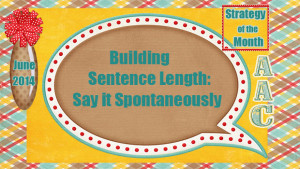
As beginning communicators start using single symbols to communicate, the next step immediately becomes to expand sentence length to two words, then three words, then more. Helping learners to use longer sentences spontaneously is the main goal. Teaching spontaneous use of longer sentences helps assure that those sentences can be used with many communication partners and in many contexts. A great facilitator strategy for helping to build sentences is ‘add a word’ or expansions and extensions. This was mentioned in last week’s post: Helping Beginning Communicators Expand Their Sentence Length but is further delineated below. What is it? ‘Add a word’ strategy is more formally called expansions and extensions. Expansions typically refer to adding a word with new conceptual knowledge while extensions add a word with new grammatical information. Expansions and extensions are a form of modeling and can be done both on a communication display as well as verbally. This... [Read More...]
Filed under: Strategy of the Month
Tagged With: expansions, extensions, Language facilitation strategies
September 20, 2013
by Robin Parker -
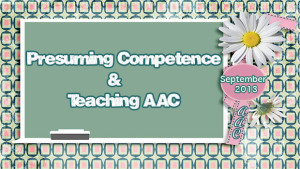
We have said this before, we say it now, and we will say it again because time and time again we are surprised in great ways. Aided Language Input Talk About Relevant Topics Talk About Age-Appropriate Topics Use Language Facilitation Techniques And….Listen to the Message, Be a Communication Partner, Have Fun!
Filed under: PrAACtical Thinking
Tagged With: aided language input, Language facilitation strategies, presume competence
August 6, 2013
by Robin Parker -

We had some great experiences this week with some awesome client’s and their families. We were reminded of this very effective language facilitation strategy: And if you need some ideas for waiting, check out 10 ways to practice waiting… for language. Waiting works best when you wait with eye brows raised (expectantly) and then if needed use a gestural cue towards the communication display and if more cueing is needed point to a more specific communication display cell(cells) as options. By then, you will probably get a self-initiated communication message. If not, model & honor the inferred intent and find another communication opportunity and wait…..
Filed under: PrAACtical Thinking
Tagged With: communication opportunity, Language facilitation strategies, wait and signal
March 18, 2013
by Robin Parker -
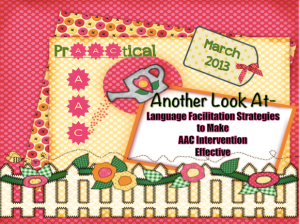
Language Facilitation Strategies The Art of Scaffolding Recasting: A Language Facilitation Strategy F is for Feedback Don’t Miss These Visual Supports & The Chance to PrAACtice Language Facilitation Strategies PrAACtical Teaching Aided Language Input Pivotal Skills for AAC Intervention: Aided Language Input Why We Love Aided Language Input Aided Language Input Demo Learning to Use Aided Language Input Teachers in AACtion- Aided Language Input 5 Ways to Elicit Language Without Asking a Question Don’t Ask: 5 Reasons to De-Emphasize Questions in Your AAC Therapy 5 Tools to Make Aided Language Input Easier F is for Feedback Video
Filed under: PrAACtical Thinking
Tagged With: Language facilitation strategies









